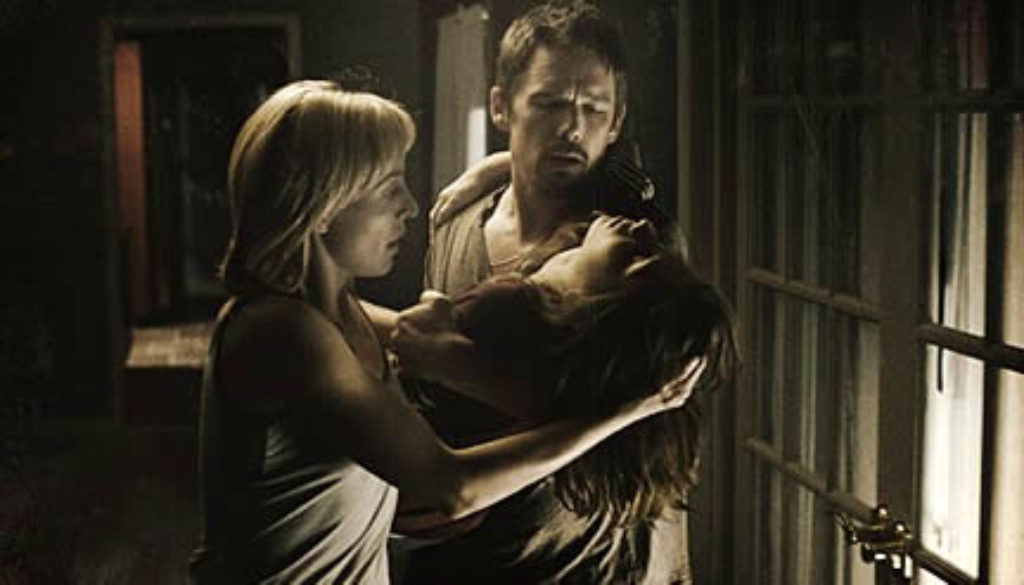
Ellison Oswalt had one hit book and he’ll do anything to have another.
It’s a burning desire that drives him.
It nags at him.
It eats him alive.
Ten years ago, Kentucky Blood, his “true crime” best-seller, not only made him the talk of the literary world, it actually helped solve the crime at its core. The two books after that one? Well, they weren’t so successful. In fact, one of them was such a stumbling disaster it earned him nothing but the ire of the police.
His current project, however, will be different. He just knows it. It’s about this terrible real-world murder of a small town family in which all but one was hanged from a tree in their own backyard. And that one, the young daughter, has gone missing. The police are baffled. And the book is going to be just perfect. Perfect!
Sure, Ellison had to uproot and move his own family again to really be able to pluck at the heart of the mystery. And it will be a struggle trying to cover two mortgages when just one was becoming a problem. But, boy, that second mortgage is worth it, ’cause it allowed him to move into the dead family’s house!
And then he finds the movies. When Ellison is moving a few things into his new attic, he makes an incredible find: an old box filled with a Super 8 projector and five canisters of film. These aren’t just average home movies, though. These profane flicks—each more horrible than the last—not only show the gruesomely hanging family, they display the bloody demise of four other families.
This is his moment of personal triumph. His denouement! Ellison believes he’s uncovered clues to a serial killer. But far better than that, for him, it could lead to bookselling success beyond even his wildest dreams.
But as our writer cracks open his first bottle—slugging back the strong liquor so he can grit his way through the rancid movies once more—he has no clue that his discovery means something much, much more than any of those things.
Or that it means something much, much worse.
[Note: Spoilers are contained in the following sections.]
Ellison’s wife, Tracy, is one of this story’s only saving graces. She’s stable, longsuffering and patient in the face of her husband’s consistently selfish choices. She reminds him—when he’s rambling on about his writing giving his life meaning and leaving behind a legacy—that their union and family give both of their lives meaning, and his children are the real legacy of his life. She warns him, “If you miss out on these years with the kids, you won’t get them back.”
Late in the movie, Ellison’s concern for his family overrules his ambition. But by then it’s too late.
At its core, this is a horror film about a demonic entity that victims (who are mostly kids) call Mr. Boogie. An occult expert labels it Bughuul, meaning eater of children. It shows up at each murder scene with a ghoulishly stark black-and-white visage. It seemingly directs the grotesque killings that then take place.
A pagan symbol, attached to Bughuul, shows up in several areas. And the occult expert opines that it’s not just something a rock band would “draw in goat’s blood to p‑‑‑ off Christians,” but that it was actually an ancient symbol of pagan ritual. It’s stated that certain early Christian groups believed simple images of Bughuul serve as a gateway to and from the entity’s dark spiritual netherworld. We see “evidence” of this as the creature carries a child into a video image.
We see several of Bughuul’s dead and decaying child victims as they duck in and out of the shadows and jump into view. We’re shown a video clip of Ellison being pulled to the floor by the hands of ghost-like children.
As she jumps out of bed in an emergency, it’s plain that Tracy isn’t wearing anything under her tight T-shirt. A mom in a video wears a cleavage-baring swimsuit.
The movie opens with an 8mm film clip showing a hooded and bound family of four, all standing beneath a large tree branch with ropes around their necks. They’re hoisted up off the ground by their throats, and we see them struggle and thrash until they die.
This is only one of the five very disturbing scenes of murder that play out on the Super 8 movies Ellison finds.
Before their subjects die, the movies ask us to connect emotionally with the different sets of family victims by showing them playing together in some way—a pool party, a fishing trip, etc. Then they move on to viscerally illustrate the bound and gagged bloody murders of each. We see a family burned to death in a car, parents getting their throats slashed while in bed, a group pulled into a pool to drown and a running lawn mower moving toward a prone victim’s face. (Viewers are spared the most graphic moments of each kill as the camera cuts away or shows the action in a reflection.)
One more example: A young girl approaches her bound family members with a large ax in her hand before the scene cuts to a hallway covered in blood spray and gore splatter. We then see the girl, with bloody hands and face, drawing a picture of people who have been chopped into chunks.
Elsewhere, Ellison falls through the attic floor and cuts his leg. He tumbles down the attic ladder to thump to the hall floor. While exploring the backyard at night, he’s threatened by a growling dog with bared teeth. Ellison’s teen son, Trevor, goes through several wide-eyed, screaming bouts of night terrors. Pictures of a crime scene show corpses with rope burns around their necks.
Seven or eight s-words. A handful of uses of “h‑‑‑.” God’s and Christ’s names are together misused four or five times. God’s name is once combined with “d‑‑n.”
As time passes, and Ellison becomes more stressed out by his discovered movies and the darkness they release, the writer graduates from drinking beer to sipping from glasses of whiskey to slugging straight from the liquor bottle. He also begins smoking.
Ellison and several of his family members are knocked unconscious by a drug put in their drinks.
Ellison makes the foolish choice of withholding key evidence for several murders from the police. And he openly deceives his wife about where they’ve moved. When she worries, “We haven’t moved into a place two doors down from the murder house again, have we?” He honestly but deceptively answers, “No.”
This is yet another horror film that leans hard on the now faddish cinematic device of found footage. In this case, that relatively new device is merged with a classic thump-in-the-dark scary pic. So, instead of simply watching some bleak, shaky home movie for an hour and a half, we watch someone else watching some bleak, shaky home movie—as footsteps creak in the shadowy hallway behind him.
Director Scott Derrickson (The Day the Earth Stood Still, The Exorcism of Emily Rose) has often talked about how, above any other genre, horror films can clearly communicate the distinction between good and evil. And, indeed, there is something of a Faustian deal at play here as the movie’s protagonist clutches at his hopes of glory and riches while slowly losing everything else of value in his life.
“Without being preachy, the film still has good moral ideas at work in it,” Derrickson said in a bloody-disgusting.com interview. “Not in a way that the movie is trying to teach you anything; it’s simply revealing some basic truths about the way we are.”
Those basic truths, though, are dark ones. This is a film that wants to peer into those afraid-of-the-dark-and-needs-a-night-light scared-little-kid recesses in all of us. It drags us into that creepy murk, and it’s not a pleasant trip. The scares and murders are not simply intense but grinding. Evil is all-powerful. And redemption, if it’s anywhere at all, is left lurking in the shadows.
The beleaguered Ellison can’t seem to keep himself from first marching, then staggering toward his inevitable doom. He’s a guy who can’t stop digging into the story, who can’t stop the clatter-clatter-click of the old Super 8 projector, who can’t stop watching the scenes in front of him even though common sense screams that he should never have ventured into this singularly focused dark nightmare to begin with.
And then the demon takes over and never relents.
Truthfully, while sitting in the audience watching this movie about Ellison watching those movies, I started to understand exactly how desperate he must have felt.


After spending more than two decades touring, directing, writing and producing for Christian theater and radio (most recently for Adventures in Odyssey, which he still contributes to), Bob joined the Plugged In staff to help us focus more heavily on video games. He is also one of our primary movie reviewers.
Our weekly newsletter will keep you in the loop on the biggest things happening in entertainment and technology. Sign up today, and we’ll send you a chapter from the new Plugged In book, Becoming a Screen-Savvy Family, that focuses on how to implement a “screentime reset” in your family!